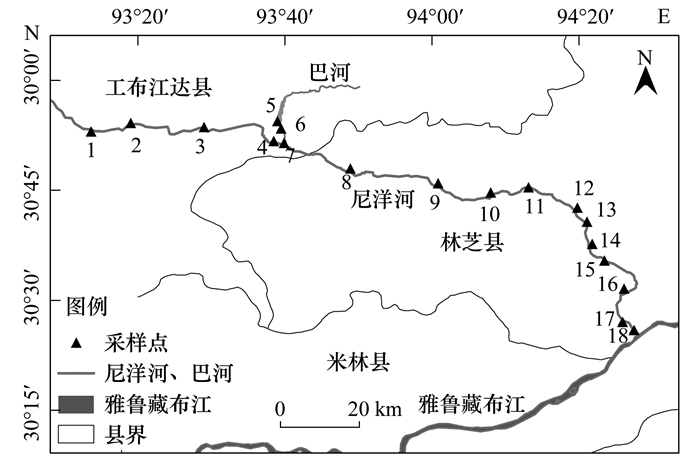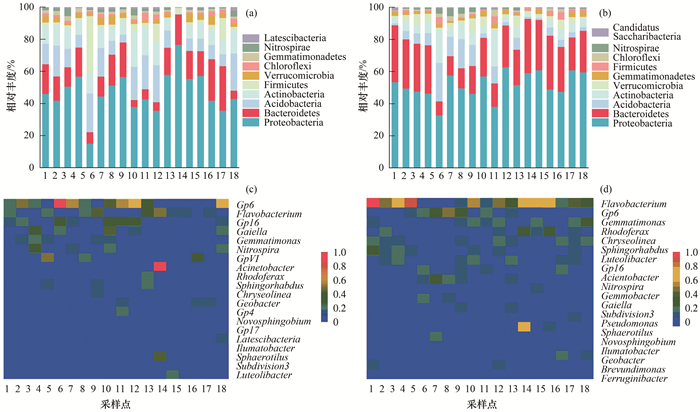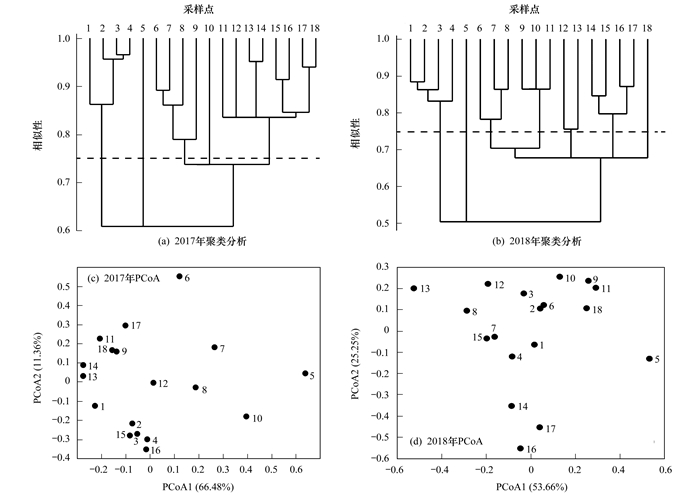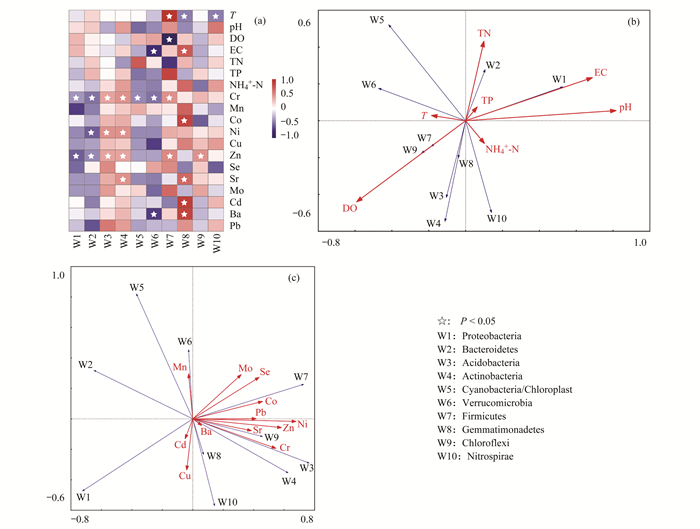2. 南京大学环境学院, 南京 210023
2. School of the Environment, Nanjing University, Nanjing 210023, China
微生物是河流生态系统中的主要分解者[1, 2].随着人类活动对河流水质环境的持续影响, 沉积到河流沉积物中的环境污染物日益增多, 沉积物成为多种微生物生存与物质交换的载体[3].沉积物中的微生物通过同化、异化等作用能够影响水环境中无机盐、有机污染物等物质的分布、迁移和转化[4], 因此研究沉积物中微生物群落的分布特征可为阐明水环境中污染物质的迁移转化规律提供基础数据支撑.同时, 微生物群落会对环境因子变化产生响应[5].研究环境因子与微生物之间的相关性, 可以更系统地阐述微生物和环境之间的关系, 对环境管理具有重要意义.
尼洋河, 又称“娘曲”, 是青藏高原雅鲁藏布江众支流中重要的一级支流, 同时也是工布江达和林芝地区重要的水源地[6].随着西部大开发和我国水能开发战略逐步转移西藏[7], 近年来对于尼洋河周边地区的开发与建设, 特别是水电站的开发建设如火如荼地进行.已有研究表明, 在尼洋河流域多布电站建成后, 尼洋河水环境质量有一定的下降趋势[8].目前已有研究对尼洋河水体中的重金属进行了调查[9].龚迎春[10]和刘海平等[11~13]对尼洋河中的浮游植物和浮游动物等进行调查, 发现尼洋河浮游植物类群以硅藻占有绝对优势, 浮游动物中原生动物以砂壳虫和瞬目虫属为主.但现在对于尼洋河沉积物中微生物群落的时空分布特征仍不明确, 对微生物群落结构与环境影响因子的关联特征仍缺乏认识.本文分析了尼洋河沉积物微生物群落结构, 研究了微生物群落的时空分布特征, 进一步确定了微生物群落结构与典型环境相关因子的相关性, 以期为尼洋河流域生态系统保护提供基础数据支撑.
1 材料与方法 1.1 样品采集与预处理本研究共设18个采样点, 具体位置如图 1所示, 采样时间为2017年11月和2018年10月.水样采集1 L, 4℃保存; 沉积物样品采用不锈钢抓斗采集湖底10 cm以下的沉积物, 4℃保存并迅速运回实验室. 1周内完成所有指标测定.

|
图 1 尼洋河采样点分布示意 Fig. 1 Distribution of sampling sites in Niyang River |
采用江苏盛奥华6B-3000A多参数水质检测仪现场测定水质理化指标, 包括pH值、电导率(EC)、溶解氧(DO)和温度(T).总氮(TN)、总磷(TP)和氨氮(NH4+-N)等采用文献[14]推荐方法.水体中铬(Cr)、锰(Mn)、钴(Co)、镍(Ni)、铜(Cu)、锌(Zn)、硒(Se)、锶(Sr)、钼(Mo)、镉(Cd)、钡(Ba)和铅(Pb)等12种金属含量采用电感耦合等离子体光谱法测定.
1.3 沉积物微生物DNA提取与PCR扩增沉积物微生物总DNA采用FastDNA® SPIN Kit试剂盒(美国, MP Biomedicals)提取, 采用NanoDrop (美国, ThermoFisher公司)和1%琼脂糖凝胶电泳对所提DNA的浓度、纯度和完整性进行检测[15], OD(260/280)值在1.8~2.0之间, 且DNA样品浓度大于50 ng ·L-1的DNA样品用于PCR扩增.扩增目标为16S rRNA的V3-V4区(目标片段约:459 bp); PCR扩增引物序列为:V3F(5′-CCTACGGGNGGCWGCAG-3′)和V4R(5′-GGACTACHVGGGTWTCTAAT-3′); PCR反应体系为:30 μL体系, 包括100 ng模板DNA、15 μL 2×EasyTaq® PCR SuperMix(北京全式金公司)、10 μmol ·L-1×2正/反向引物和5 μL ddH2O, 每个样品设置4个平行样; PCR扩增通过Veriti96 PCR仪(美国, ABI)完成, 扩增条件为:95℃预变性2 min; PCR循环数为30次, 依次为95℃变性20 s, 51℃退火30 s, 72℃延伸60 s; 最后72℃延伸5 min.采用QIAquick PCR Purification Kit(德国, QIAGEN)对PCR产物进行纯化后用于后续测序.
1.4 16S沉积物微生物基因测序及微生物群落分析采用TruSeq® DNA Sample Preparation建库试剂盒加上接头以及对应的Barcode, 构建形成16S rRNA基因测序的文库.构建好的测序文库采用Illumina MiSeq(美国, Illumina)测序平台进行测序试验, 测序方案为2×250 bp两端测序[16].根据文献[17]的方法, 使用Mothur软件平台进行原始数据质量过滤、降噪、去嵌合体, 以及去除非细菌序列等质量控制操作.将统一测序深度的clean reads提交到QIIME平台进行基于可操作分类单元(OTUs)的微生物物种分类信息注释, 相似度参数设置为0.97[18].利用RDP Classifier的算法通过比对Greengenes数据库(http://greengenes.secondgenome.com)进行从门水平到属水平的物种分类信息注释.使用PAST软件对不同样品的细菌群落进行RDP分类群的聚类分析.
1.5 数据处理与统计分析热图及主坐标分析(PCoA)由R平台(V3.1.3)的“Vegan”和“gplots”包进行, 冗余分析(RDA)采用Canoco 4.5软件, 聚类分析采用Past 3.0软件中的未加权对群算法(UPGMA)进行.其他统计分析及图表采用Graphpad Prism 6和Origin 9.0完成.
2 结果与讨论 2.1 微生物群落结构特征及时间变化沉积物微生物的高通量测序结果显示, 2018年尼洋河沉积物样品中共检出36个细菌门和一定量未明确分类的微生物.各位点细菌丰度排名前10的OTUs如图 2(a).变形菌门(Proteobacteria)、拟杆菌门(Bacteroidetes)、酸杆菌门(Acidobacteria)、放线菌门(Actinobacteria)、疣微菌门(Verrucomicrobia)、厚壁菌门(Firmicutes)、芽单胞菌门(Gemmatimonadetes)、绿弯菌门(Chloroflexi)、硝化螺旋菌门(Nitrospirae)和拟杆菌门(Latescibacteria)是尼洋河沉积物中的优势微生物, 它们的丰度占整个微生物群落的69.1% ~96.7%. 2017年和2018年的沉积物微生物群落结构具有很高的相似性[图 2(b)].主要区别在于Candidatus Saccharibacteria在2017年属于排行前10的优势微生物, 而2018年Latescibacteria取代其进入了前10.除5号位点外, 其他位点沉积物中Proteobacteria均为优势菌门, 2017年各位点Proteobacteria丰度平均占比50.75%, 2018年各位点Proteobacteria丰度平均占比41.02%.Proteobacteria是沉积物中具有代表性的细菌群落分支, 也是淡水水体中的典型优势微生物[19~23].Proteobacteria中诸多微生物具有脱氮除磷、降解污染物等能力, 是水体自净功能的重要承担者[24, 25].

|
(a)2018年门水平微生物相对丰度; (b)2017年门水平微生物相对丰度;(c)2018年属水平微生物相对丰度; (d)2017年属水平微生物相对丰度 图 2 尼洋河沉积物微生物群落结构 Fig. 2 Microbial community structure of sediments in Niyang River |
从属水平对沉积物微生物群落结构进行更深入分析.选取丰度占比1%以上的2018年沉积物微生物进行热图分析, 结果见图 2(c).微生物丰度较高的属包括黄杆菌属(Flavobacterium)和Gp 16属等.对于2017年沉积物, Flavobacterium为主要微生物, 其他丰度较高的菌属包括Gp6属、芽单胞菌属(Gemmatimonas)和红育菌属(Rhodoferax)等[图 2(d)], 与2018年属水平微生物群落结构相类似.Flavobacterium在生态系统中是一类具有反硝化优势的功能菌, 广泛分布于淡水水体[26].此外, 尼洋河多个点位的沉积物可检出条件致病菌[27], 如不动杆菌属(Acinetobacter)、分支杆菌属(Mycobacterium)、链球菌属(Streptococcus)和军团菌属(Legionella)等, 还有鱼类致病菌[28, 29], 如气单胞菌属(Aeromonas)等.一些特殊位点的致病菌丰度较高, 如13号沉积物中的Acinetobacter丰度非常高. 13号位点靠近养猪场废水排水口, 可能是此种条件致病菌显著升高的重要原因, 需要引起足够重视.当然, 由于高通量测序具有灵敏度极高的特点, 致病菌易出现假阳性现象[30], 因此尼洋河致病菌需要使用其他方法进一步分离和鉴别, 以准确确定其潜在的健康风险.
2.2 微生物结构空间分布特征尼洋河沉积物微生物群落结构聚类分析显示, 2017年18个位点微生物可分为5类, 其中5号和10号样品各自单独为一类, 1~4、6~9和11~18号样品分为3类[图 3(a)]. 2018年18个位点微生物则可分为7类[图 3(b)], 其中5号和18号各自单独为一类, 其他5类为1~4、6~8、9~11、12~13和14~17号.两年的底泥微生物结构聚类虽略有不同, 但在空间上都呈现出分段式的特征, 不同河段的微生物群落之间存在一定差异.进一步对门水平微生物结构进行PCoA分析, 结果如图 3(c)和图 3(d)所示.空间距离相近的采样点在PCoA图中距离较近, 说明其微生物群落结构类似.上述两种分析结果可以确定尼洋河上游、中游和下游之间存在一定差异.Liu等[31]利用分类回归树(CART)年代学分析, 认为海拔3 308 m以上时, 尼洋河附生原生动物总丰度和Shannon-Wiener多样性指数较高, 因此海拔可能是使尼洋河沉积物中微生物群落测序结果出现空间差异的原因.此外, 5号点位的沉积物微生物群落结构与其他位点显著不同, 5号点位于电站库区, 库区水流速度等水文条件与其他点位存在较大差异, 水文过程对水体沉积物微生物群落结构存在剧烈影响也在定量研究中被证实[32, 33], 水文条件可能通过改变植物生长状况而影响沉积物中养分状况, 进而对微生物群落结构产生影响.本研究发现电站对底泥微生物结构存在影响, 值得开展更进一步的研究确定这种影响的规律.

|
图 3 尼洋河底泥微生物群落结构聚类分析及PCoA分析 Fig. 3 Results of clustering analysis and PCoA analysis of microbial community structure in Niyang River sediments |
为分析尼洋河微生物群落与环境因子的相关性, 选择2018年尼洋河各采样点水样为代表进行了分析.尼洋河18个采样点位水温差异较大, 水温最高为15.5℃(13号), 最低为8.4℃(1号), 平均水温为12.8℃(表 1).但各位点水体pH值差异不显著, 平均值为8.61.水体DO值较高, 可能与尼洋河流速快, 水体扰动较大有关.水体EC值较低, 表明尼洋河河水整体离子浓度偏低.对于水体中的TP、TN和NH4+-N含量, 1号点样品中TP和TN含量最高, 整体呈现上游含量高于下游的趋势.对比上述水体理化参数, 13号采样点的所有指标与邻近位点比较出现异常, 该位点靠近养猪场废水排水口, 可能是造成该点位水质相关指标变化的主要原因.另外, 16号位点的营养元素指标值也比临近位点高, 16号位点靠近林芝县城区, 存在生活污水排入.综合上述指标, 人类的生产和生活活动可能是造成尼洋河下游(13号和16号)理化指标波动的重要原因.
|
|
表 1 尼洋河水体理化指标 Table 1 Physical and chemical indexes of Niyang River |
尼洋河水体中12种典型金属浓度分析结果如图 4所示.尼洋河中金属整体含量较低, 18个采样点中目标重金属浓度水平均低于地表水环境质量标准(GB 3838-2002).结合吕琳莉等[9]对西藏尼洋河河水体重金属分布特征的调查结果, 尼洋河整体未受到重金属污染.

|
图 4 尼洋河水体中金属含量 Fig. 4 Metal concentrations in water of Niyang River |
基于上述获得的尼洋河沉积物微生物门水平丰度及环境因子含量, 采用Spearman相关分析和RDA分析对微生物群落与环境因子的相关性进行了研究.Spearman相关分析结果显示, 尼洋河水体T、DO和EC及金属含量与特定微生物门水平丰度存在一定相关性[图 5(a)].Cr和Zn是与尼洋河沉积物微生物种类相关性最高的两种因子.其中, Cr与Proteobacteria、Bacteroidetes、Cyanobacteria/Chloroplast和Verrucomicrobia呈显著负相关, 与Acidobacteria、Actinobacteria和Firmicutes呈正相关.Zn含量与Proteobacteria和Bacteroidetes呈显著负相关, 与Acidobacteria、Actinobacteria、Firmicutes和Chloroflexi呈显著正相关.Gemmatimonadetes与T、EC及Co、Sr、Cd和Ba含量均呈现显著相关关系.

|
(a)Spearman相关分析; (b)微生物群落与理化指标的RDA分析; (c)微生物群落与重金属的RDA分析 图 5 微生物群落与环境因子的关联分析 Fig. 5 Analysis of relationship between the microbial community and environmental factors |
基于RDA分析, TN、TP和DO是微生物群落结构的主要影响因子[图 5(b)].TN与Acidobacteria、Actinobacteria和Gemmatimonadetes丰度呈现显著负相关, 与Bacteroidetes丰度呈现显著正相关; Chloroflexi和Firmicutes丰度与TN呈现显著负相关, 但与DO呈显著正相关; Proteobacteria丰度与EC呈显著正相关, 与DO呈显著负相关.Cr、Sr、Ba和Mn等为尼洋河沉积物中微生物群落结构的重要影响因子[图 5(c)].Cr、Sr和Ba等与Acidobacteria、Actinobacteria和Chloroflexi等丰度呈显著正相关, 与Bacteroidetes丰度显著负相关; Mn与Verrucomicrobia丰度显著正相关, 与Gemmatimonadetes和Nitrospirae丰度呈现显著负相关; Proteobacteria丰度与Mo和Se呈现显著负相关.Rajapaksha等[34]的研究发现, 革兰氏阴性菌中Flavobacterium等7个属对金属有耐受作用.江玉梅等[35]就鄱阳湖沉积物中重金属含量对微生物群落的影响进行研究, 发现Cu、Zn、Cd、Pb、Cr和Mn与138个主要OTU显著相关.本研究也发现尼洋河沉积物中与多种金属呈正相关的菌门, 这些正相关的菌群可能是金属污染修复的重要微生物种质资源, 这对尼洋河水环境管理与生态修复具有重要意义.但尼洋河沉积物微生物群落结构与环境因子相互关系的具体机制较为复杂, 不是简单的线性关系, 相关分析和RDA分析所能解释的响应有限, 更为具体的响应机制还需进行更深入和更系统地探究.
3 结论(1) 尼洋河沉积物中Proteobacteria是优势菌门.属水平上Flavobacterium丰度较高, Aeromonas等条件致病菌属可被检出.
(2) 2017年和2018年沉积物微生物门水平特征基本相同, 属水平特征相似.在空间差异性方面, 上游、中游、下游不同河段沉积物微生物群落之间存在差异, 电站库区沉积物微生物群落具有特异性.
(3) 尼洋河水体环境因子(如T、DO和TP及金属等)对沉积物中微生物群落结构具有显著影响.更具体的响应机制仍需更深入地研究分析.
| [1] | Schindler M H, Gessner M O. Functional leaf traits and biodiversity effects on litter decomposition in a stream[J]. Ecology, 2009, 90(6): 1641-1649. DOI:10.1890/08-1597.1 |
| [2] | Hättenschwiler S, Tiunov A V, Scheu S. Biodiversity and litter decomposition in terrestrial ecosystems[J]. Annual Review of Ecology, Evolution, and Systematics, 2005, 36: 191-218. DOI:10.1146/annurev.ecolsys.36.112904.151932 |
| [3] | Frey S D, Lee J, Melillo J M, et al. The temperature response of soil microbial efficiency and its feedback to climate[J]. Nature Climate Change, 2013, 3(4): 395-398. DOI:10.1038/nclimate1796 |
| [4] | Vymazal J. Removal of nutrients in various types of constructed wetlands[J]. Science of the Total Environment, 2007, 380(1-3): 48-65. DOI:10.1016/j.scitotenv.2006.09.014 |
| [5] |
赵兴青, 杨柳燕, 尹大强, 等. 不同空间位点沉积物理化性质与微生物多样性垂向分布规律[J]. 环境科学, 2008, 29(12): 3537-3545. Zhao X Q, Yang L Y, Yin D Q, et al. Vertical distribution of physicochemical characteristics and the microbial diversity in different spatial sediments samples in Lake Taihu[J]. Environmental Science, 2008, 29(12): 3537-3545. DOI:10.3321/j.issn:0250-3301.2008.12.041 |
| [6] |
扎西达瓦. 浅谈尼洋河水能开发规划及环境保护措施[J]. 西藏科技, 2014(6): 26-28, 41. Zahidava. A brief discussion on the development planning and environmental protection measures of the Niyang River[J]. Tibet's Science and Technology, 2014(6): 26-28, 41. DOI:10.3969/j.issn.1004-3403.2014.06.007 |
| [7] |
马继洋. 浅谈西藏产业结构调整和可再生能源开发的关系[J]. 西藏科技, 2009(11): 24-27. Ma J Y. Discuss simply relation of Tibet industrial structure adjustment and renewable energy development[J]. Tibet's Science and Technology, 2009(11): 24-27. DOI:10.3969/j.issn.1004-3403.2009.11.010 |
| [8] |
张永恒, 宗永臣. 多布电站对尼洋河八一段水环境影响综合评价研究[J]. 高原农业, 2018, 2(4): 427-432. Zhang Y H, Zong Y C. Study on the comprehensive evaluation of the influence of Duobu hydropower station on the water environment of Niyang River in Bayi[J]. Journal of Plateau Agriculture, 2018, 2(4): 427-432. |
| [9] |
吕琳莉, 李朝霞, 黄毅, 等. 西藏尼洋河水体重金属分布特征及风险评价[J]. 农业工程学报, 2019, 35(9): 193-199. Lü L L, Li Z X, Huang Y, et al. Distribution characteristics and risk assessment of heavy metals in Niyang River, Tibet[J]. Transactions of the Chinese Society of Agricultural Engineering, 2019, 35(9): 193-199. |
| [10] |
龚迎春, 冯伟松, 余育和, 等. 西藏尼洋河流域浮游动物群落结构研究[J]. 水生态学杂志, 2012, 33(6): 35-43. Gong Y C, Feng W S, Yu Y H, et al. Characteristics of zooplankton community structure in Niyang River basin of Tibet[J]. Journal of Hydroecology, 2012, 33(6): 35-43. |
| [11] |
刘海平, 叶少文, 杨雪峰, 等. 西藏尼洋河水生生物群落时空动态及与环境因子的关系:1.浮游植物[J]. 湖泊科学, 2013, 25(5): 695-706. Liu H P, Ye S W, Yang X F, et al. Spatial-temporal dynamics of aquatic organism community and their relationships to environment in Niyang River, Tibet:1. Phytoplankton[J]. Journal of Lake Sciences, 2013, 25(5): 695-706. |
| [12] |
刘海平, 叶少文, 杨雪峰, 等. 西藏尼洋河水生生物群落时空动态及与环境因子关系:2.着生藻类[J]. 湖泊科学, 2013, 25(6): 907-915. Liu H P, Ye S W, Yang X F, et al. Spatio-temporal dynamics of aquatic organism community and their relationships to environment in Niyang River, Tibet:2. Periphytic algae[J]. Journal of Lake Sciences, 2013, 25(6): 907-915. |
| [13] |
刘海平, 叶少文, 杨雪峰, 等. 西藏尼洋河水生生物群落时空动态及与环境因子关系:4.浮游动物[J]. 湖泊科学, 2016, 28(2): 370-378. Liu H P, Ye S W, Yang X F, et al. Spatio-temporal characteristics of aquatic organism community and their relationship to environment in Niyang River, the branch of Yarlung Zangbo River, Tibet:4. Zooplankton[J]. Journal of Lake Sciences, 2016, 28(2): 370-378. |
| [14] | 国家环境保护总局. 水和废水监测分析方法[M]. (第四版). 北京: 中国环境科学出版社, 2002: 836. |
| [15] |
李明月, 杨雨虹, 米铁柱, 等. 海洋沉积物中细菌DNA和RNA水平群落差异[J]. 环境科学, 2020, 41(5): 2485-2495. Li M Y, Yang Y H, Mi T Z, et al. Differences between DNA- and RNA-based bacterial communities in marine sediments[J]. Environmental Science, 2020, 41(5): 2485-2495. |
| [16] |
杨浩, 张国珍, 杨晓妮, 等. 16S rRNA高通量测序研究集雨窖水中微生物群落结构及多样性[J]. 环境科学, 2017, 38(4): 1704-1716. Yang H, Zhang G Z, Yang X N, et al. Microbial community structure and diversity in cellar water by 16S rRNA high-throughput sequencing[J]. Environmental Science, 2017, 38(4): 1704-1716. |
| [17] | Guo X C, Miao Y, Wu B, et al. Correlation between microbial community structure and biofouling as determined by analysis of microbial community dynamics[J]. Bioresource Technology, 2015, 197: 99-105. DOI:10.1016/j.biortech.2015.08.049 |
| [18] | Yin J B, Wu B, Liu S, et al. Rapid and complete dehalogenation of halonitromethanes in simulated gastrointestinal tract and its influence on toxicity[J]. Chemosphere, 2018, 211: 1147-1155. DOI:10.1016/j.chemosphere.2018.08.039 |
| [19] |
林海, 蔡怡清, 李冰, 等. 北京市妫水河底泥微生物群落结构特征[J]. 生态学报, 2019, 39(20): 7592-7601. Lin H, Cai Y Q, Li B, et al. Characteristics of microbial community structure in Guishui river sediment in Beijing[J]. Acta Ecologica Sinica, 2019, 39(20): 7592-7601. |
| [20] |
张雅洁, 李珂, 朱浩然, 等. 北海湖微生物群落结构随季节变化特征[J]. 环境科学, 2017, 38(8): 3319-3329. Zhang Y J, Li K, Zhu H R, et al. Community structure of microorganisms and its seasonal variation in Beihai Lake[J]. Environmental Science, 2017, 38(8): 3319-3329. |
| [21] |
贾远航, 靳振江, 袁武, 等. 会仙岩溶湿地、稻田与旱地土壤细菌群落结构特征比较[J]. 环境科学, 2019, 40(7): 3313-3323. Jia Y H, Jin Z J, Yuan W, et al. Comparison of soil bacterial community structure between paddy fields and dry land in the Huixian Karst Wetland, China[J]. Environmental Science, 2019, 40(7): 3313-3323. |
| [22] |
周石磊, 孙悦, 张艺冉, 等. 基于网络分析解析水源水库春季水体反硝化群落演变特征及驱动因素[J]. 环境科学, 2020, 41(4): 1666-1675. Zhou S L, Sun Y, Zhang Y R, et al. Evolution characteristics and driving factors of denitrification community based on network analysis in the process of spring thermal layer formation in Zhoucun reservoir[J]. Environmental Science, 2020, 41(4): 1666-1675. |
| [23] |
苏瑶, 许育新, 安文浩, 等. 基于微生物生物完整性指数的城市河道生态系统健康评价[J]. 环境科学, 2019, 40(3): 1270-1279. Su Y, Xu Y X, An W H, et al. Assessment of ecosystem health of an urban river based on the microbe index of biotic integrity (M-IBI)[J]. Environmental Science, 2019, 40(3): 1270-1279. |
| [24] |
王杨, 朱斌, 童俊, 等. 基于活性微生物特征的供水管壁生物膜生长特性[J]. 环境科学, 2019, 40(2): 853-858. Wang Y, Zhu B, Tong J, et al. Growth features of water supply pipeline biofilms based on active microorganisms[J]. Environmental Science, 2019, 40(2): 853-858. |
| [25] |
杨宏, 李会琳, 路璐. 嘉陵江(南充段)水体及其底泥中氨氧化微生物群落空间分布特征及其与环境因子关系[J]. 长江流域资源与环境, 2018, 27(8): 1836-1846. Yang H, Li H L, Lu L. Spatial distribution of ammonia-oxidizing microorganism in surface water and sediment in Jialing River (Nanchong section) and their relationship with environmental factors[J]. Resources and Environment in the Yangtze Basin, 2018, 27(8): 1836-1846. |
| [26] | Kanaly R A, Harayama S. Biodegradation of high-molecular-weight polycyclic aromatic hydrocarbons by bacteria[J]. Journal of Bacteriology, 2000, 182(8): 2059-2067. DOI:10.1128/JB.182.8.2059-2067.2000 |
| [27] | Schmidt A S, Bruun M S, Dalsgaard I, et al. Occurrence of antimicrobial resistance in fish-pathogenic and environmental bacteria associated with four Danish rainbow trout farms[J]. Applied and Environmental Microbiology, 2000, 66(11): 4908-4915. DOI:10.1128/AEM.66.11.4908-4915.2000 |
| [28] | Nayak S K. Role of gastrointestinal microbiota in fish[J]. Aquaculture Research, 2010, 41(11): 1553-1573. DOI:10.1111/j.1365-2109.2010.02546.x |
| [29] | 马富平.主养草鱼池塘微生物群落结构分析及嗜水气单胞菌拮抗菌筛选[D].重庆: 西南大学, 2017. http://cdmd.cnki.com.cn/Article/CDMD-10635-1017847422.htm |
| [30] |
朱飞舟, 陈利玉, 陈汉春. 16S rRNA基因序列分析法鉴定病原细菌[J]. 中南大学学报(医学版), 2013, 38(10): 1035-1041. Zhu F Z, Chen L Y, Chen H C. Identification of pathogenic microorganism by sequencing 16S rRNA gene[J]. Journal of Central South University (Medical Science), 2013, 38(10): 1035-1041. DOI:10.3969/j.issn.1672-7347.2013.10.010 |
| [31] | Liu H P, Ye S W, Yang X F, et al. Spatio-temporal variability of periphytic protozoa related to environment in the Niyang River, Tibet, China[J]. Chinese Journal of Oceanology and Limnology, 2017, 35(3): 489-500. DOI:10.1007/s00343-017-5274-7 |
| [32] |
邹锋, 李金前, 韩丽丽, 等. 鄱阳湖湿地土壤微生物活性对年际水文变化的响应[J]. 湖泊科学, 2019, 31(2): 551-559. Zou F, Li J Q, Han L L, et al. Response of soil microbial functional traits to annually hydrological changes in Lake Poyang wetlands[J]. Journal of Lake Sciences, 2019, 31(2): 551-559. |
| [33] |
王静, 王冬梅, 任远, 等. 漓江河岸带不同水文环境土壤微生物与土壤养分的耦合关系[J]. 生态学报, 2019, 39(8): 2687-2695. Wang J, Wang D M, Ren Y, et al. Coupling relationships between soil microbes and soil nutrients under different hydrologic conditions in the riparian zone of the Lijiang River[J]. Acta Ecologica Sinica, 2019, 39(8): 2687-2695. |
| [34] | Rajapaksha R M C P, Tobor-Kaplon M A, Bååth E. Metal toxicity affects fungal and bacterial activities in soil differently[J]. Applied and Environmental Microbiology, 2004, 70(5): 2966-2973. DOI:10.1128/AEM.70.5.2966-2973.2004 |
| [35] |
江玉梅, 张晨, 黄小兰, 等. 重金属污染对鄱阳湖底泥微生物群落结构的影响[J]. 中国环境科学, 2016, 36(11): 3475-3486. Jiang Y M, Zhang C, Huang X L, et al. Effect of heavy metals in the sediment of Poyang Lake estuary on microbial communities structure base on Mi-seq sequencing[J]. China Environmental Science, 2016, 36(11): 3475-3486. DOI:10.3969/j.issn.1000-6923.2016.11.034 |
 2020, Vol. 41
2020, Vol. 41


